C. Vulgaris needs what every plant needs to grow: food, light, CO2, and space. We are working to optimize these variables to achieve the maximum algae growth per unit volume- a key hurdle in commercializing algae biofuels.
One way we are currently working towards this end is the light box which will provide light, CO2, and space for the algae. Based upon a plant light box system built by Wisconsin Fast Plants, we are creating a container to grow the algae in that can deliver everything necessary for its growth.
The light box’s structure is made from two milk crates. The bottom crate is used to store homeostatic equipment (light timer, stir plate, CO2 source,) while the top milk crate contains the algae.
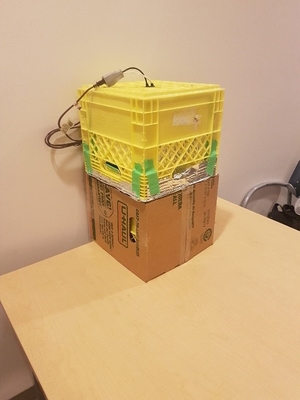 |
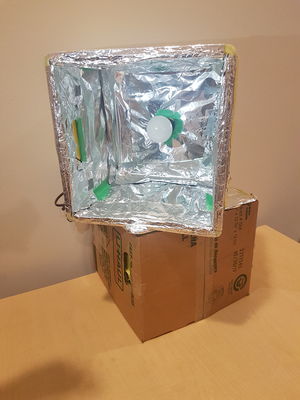 |
The beginnings the algae lightbox. An exterior view (left) and interior view highlighting the light (right).
The key considerations guiding the lightbox construction process are outlined below:
Light is needed for photosynthesis - the driving mechanism behind lipid and sugar production in plant cells. The light box’s interior is coated with aluminum foil to reflect as much light as possible to the algae growth medium. A bright LED bulb produces the light.
The light source is connected to a timer. While at first it may seem logical to maximize the radiant energy shining on the algae to maximize growth, this is not the case. Photosynthesis involves a series of reduction-oxidation chemical reactions and too much light can result in oxidative stress, reducing algae growth. Plants need a period of darkness to repair oxidative damage [1].
Apart from radiant energy, light also produces thermal energy. C. Vulgaris grows best at 36 ⁰C, well above room temperature [2]. Using a powerful light bulb in such a small space will serve as an effective heat source for maintaining the elevated temperature. The light box is wrapped in a layer of cardboard to for insulation purposes.
The ratio of light/dark cycles per day will act as a composite parameter in future experiments. Its effect on algae growth represents the net impact of photosynthetic and temperature considerations.
Carbon dioxide is needed for photosynthesis and acts as the carbon source for the biofuels. The atmosphere contains around 400 ppm CO2 . Algae grows around 200% faster at CO2 concentrations of 100,000 ppm, 250 times more CO2 than ambient levels [3]. The lightbox needs a way to deliver this CO2 to the algae. We are considering two methods of CO2 delivery: sparging and fermentation. Many photobioreactors use CO2 feed lines that sparge CO2 directly into the algae growth medium. This is likely the most efficient method of CO2 delivery, however it can be costly given the current scale of our project.
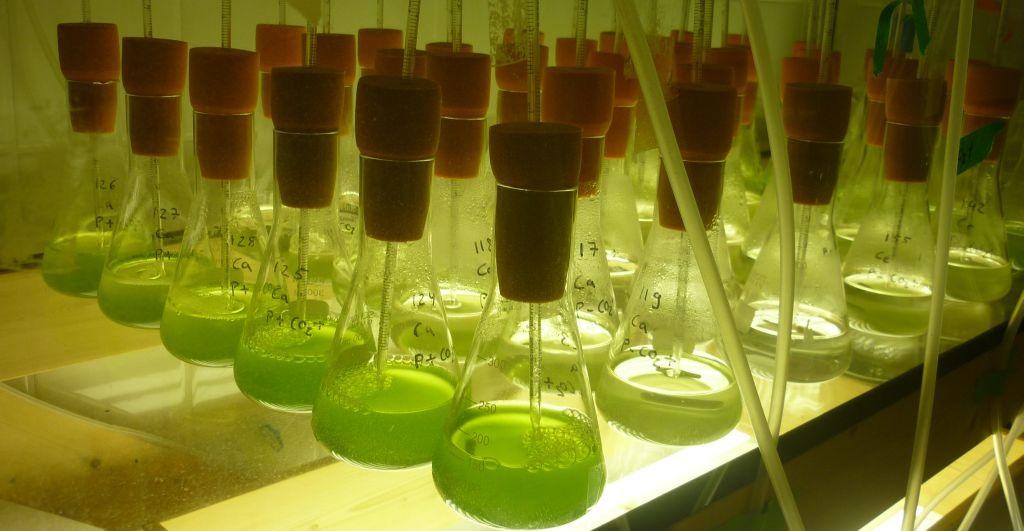 Algae growth flasks contacting CO2 feed lines. [Photo taken by the University of Potsdam.]
Algae growth flasks contacting CO2 feed lines. [Photo taken by the University of Potsdam.]
Fermentation is an alternative CO2 delivery system used in some greenhouses. Adding a bag of Mycelium (a fungus) to the bottom milk crate would act as source of CO2 by fermenting. The airtightness of the light box would be an important consideration with fermentation.
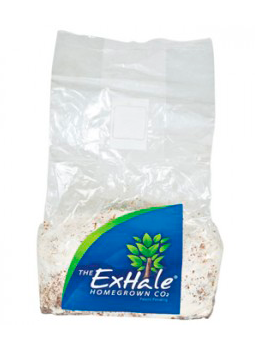 An ExHale bag. It contains enough Mycelium to produce CO2 for the light box for 6 months.
An ExHale bag. It contains enough Mycelium to produce CO2 for the light box for 6 months.
Space is more complicated than it may seem. Putting the algae in a 1 L flask does not mean it has 1 L of space to grow. Algae is denser than its growth medium and tends to sink to the bottom of its container. When the algae grows in an agglomeration, the algae on the bottom can become somewhat cut off from the CO2, food, and nutrients in the growth media. Moreover, the cells in the bottom are surrounded by the waste products of other cells. This can reduce algae growth. To fix the problem of cells settling out of the solution, the solution must be stirred. A magnetic stir bar will be added to the algae flasks in the light box and the bottom milk crate will contain a magnetic stir plate. We are currently deciding whether to construct the stir plate ourselves or purchase one.
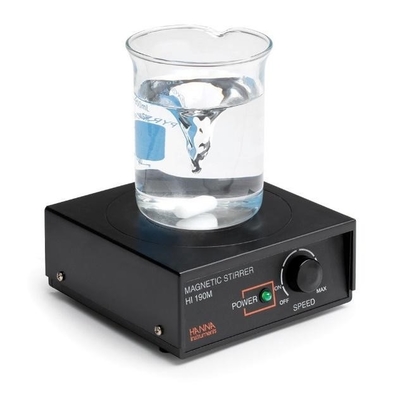 A magnetic stir plate in action. [Photo taken by Hanna Instruments.]
A magnetic stir plate in action. [Photo taken by Hanna Instruments.]
[1] Sforza, E. et al. (2012). Adjusted light and dark cycles can optimize photosynthesis efficiency in algae growing in bioreactors. PLOS One,(7)6. DOI: 10.1371/journal.pone.0038975
[2] Filali, R. et al. (2011). Estimation of Chlorella vulgaris growth rate in a continuous photobioreactor. The International Federation of Automatic Control. DOI: 10.3182/20110828-6-IT-1002.02025
[3] Sliah, F.M. (2011). Microalgae tolerance to high concentrations of carbon dioxide: a review. Journal of Environmental Science,2(1) 648-654. DO1: 10.4236/jep.2011.25074